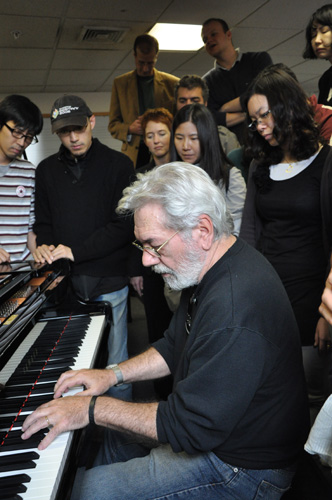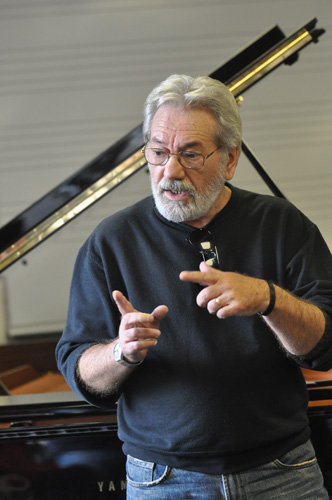In the Company of a Master: Cesar Camargo Mariano

Cesar Camargo Mariano performs at a clinic.
Photo by Phil Farnsworth

Cesar Camargo Mariano speaks at a Berklee clinic.
Photo by Phil Farnsworth

Cesar Camargo Mariano performs to a sold-out crowd at Cafe 939.
Photo by Phil Farnsworth
More than 50 students and faculty squeezed into room 4Z3 among the keyboards, dual grand pianos, and audio equipment in hushed anticipation of sitting face-to-face for two hours with a master: Cesar Camargo Mariano. What a treat to find that this man of such imposing talent, skill, and credentials would be so generous and unassuming.
Not that he toys with any false humility. The pianist/composer knows who he is and what he's accomplished—35 albums as arranger, music director, accompanist, and/or producer for top Brazilian artists such as Elis Regina, Wilson Simonal, and even the great Antonio Carlos Jobim. In his own words, Camargo, 65, has had "a career as old as the bossa nova," and after accumulating 50 years of life lessons, he was eager to share his knowledge.
The clinic began amidst quiet reverence from the audience, while Camargo struggled at first to express in English the crux of a career that took place, for half a century, primarily in Portuguese. However, the sincerity and urgency of his message minimized any language obstacles. A self-taught arranger and orchestrator, Camargo finds it difficult to teach these skills because he did not learn from any particular method. Still, he implored us to ask questions, or to email or call him later, so that he could pass on his experience to the younger generation.
Summing up his approach to his work, Camargo insisted, "Most important, I'm an artist."
Before he writes an arrangement, he needs "to know a lot about the composition, the composer, the lyrics, in order to understand the many possible interpretations" of a piece of music, he told the class.
He offered the example of "É Com Esse Que Eu Vou," originally a simple, light-hearted folk melody associated with Brazil's famous Carnaval celebration. While Camargo was music director for Elis Regina, they found themselves in need of one more song in order to complete the 1973 release Elis. They wanted to find a song to reflect the cultural and political struggles of daily Brazilian life in the 1970s.
After days of searching, Regina came to Camargo with the idea of recording the Carnaval song. Camargo initially rejected the idea, reminding her that it was a silly melody without much substance. She persisted, singing the lyrics with a new conviction in a slow, processional-like rhythm whose somber mood supplanted the previously carefree melody. Camargo realized that the lyrics took on new meaning when sung this way and that they spoke to the realities of the day, he recalled. Regina's grave interpretation of the Carnaval song immediately dictated the arrangement to Camargo—the harmony and mood would have to change.
A Crash-Course in Samba
Many who attended the clinic were ardent admirers of Camargo's unique and graceful approach to playing Brazilian samba on the piano. He delighted his fans with an unlikely tale about how he developed this style. He recalled how as a young man he listened to both traditional Brazilian music, such as chorinho, and North American jazz. The latter became the preferred style for Camargo, who imitated great pianists such as Erroll Garner, Oscar Peterson, Nat King Cole, and others when performing with his trio.
He recounted the story of how a venue owner who had hired his trio for a gig came over to the bandstand and requested that they play a samba. Camargo insisted that he didn't have any idea as to how to play samba on piano—it was guitar music! The trio continued to play in the style of a traditional jazz piano trio. The owner returned shortly and insisted on a samba, but Camargo maintained that he did not have the skills to play one. The owner put the pressure on, and Camargo realized that he had better get resourceful, and quickly.
Desperate, he turned to his fellow musicians for advice. All they offered was, "You better play a samba, man." In a moment of inspiration, Camargo tried an experiment: He adapted the left hand rhythmic style of his favorite pianist, Errol Garner, moving the quarter notes over by one eighth note, so that his left hand played chords on all the upbeats. He played a popular samba melody in his right hand, and voilá, he was playing a grooving samba with his trio. The owner was placated, and history was made.
Camargo's classroom visit is just one example of how he gave generously of his time and talent while in Boston celebrating 50 years of bossa nova with Berklee. In addition to the classroom clinic on October 1, he performed that same evening to a sold-out audience in Berklee's new performance venue, Cafe 939. The next afternoon, he held court for faculty and students in room 511 of the 921 Boylston building. Later that evening, Piano Department assistant professor Leo Blanco introduced Camargo at the Jorge Hernandez Cultural Center in Boston's South End, where he performed piano solo, then with a trio. The exciting week of activities, produced by Blanco and the External Affairs Division, ended with another sold-out performance at Cafe 939. Eighth-semester performance major Junya Fukumoto, from Kawasaki, Japan, attended all five events and beamed, "Those three days were amazing. I learned a lot from him."
